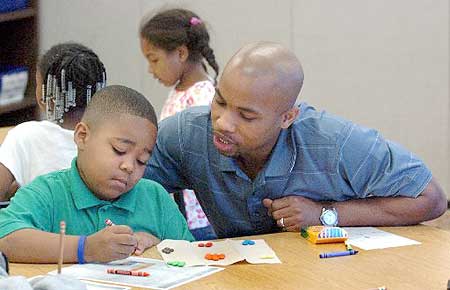Education
Evaluating Teachers by Student Improvement

By Akosua K. Albritton
 New York City still wrestles with the questions: Is it that Latoya cannot spell? Or is it that Latoya’s mother works two jobs and isn’t going to Parents’ Night? Or is it that Mrs. Franken has not set up a print-rich environment? Or is it that Mr. Dixon, the principal, is not even observing the classrooms in his building at least two times a week? The Board of Regents for the NYS Department of Education ponders these scenarios and periodically will draft another tool to assess teacher and school administration effectiveness.
New York City still wrestles with the questions: Is it that Latoya cannot spell? Or is it that Latoya’s mother works two jobs and isn’t going to Parents’ Night? Or is it that Mrs. Franken has not set up a print-rich environment? Or is it that Mr. Dixon, the principal, is not even observing the classrooms in his building at least two times a week? The Board of Regents for the NYS Department of Education ponders these scenarios and periodically will draft another tool to assess teacher and school administration effectiveness.
The current assessment is the Annual Professional Performance Review (APPR) for use during the 2015/16 through 2018/19 school terms. There is a moratorium on using standardized tests for teacher evaluations during this period. The APPR uses external and internal professionals to observe classroom teachers and principals in elementary schools, middle schools and high schools. The educators’ teaching or leadership effectiveness is judged by using a four-scale rating system where the teachers and principals are deemed either:
Highly Effective (H): 90-100% of students meet or exceed Student Learning Objectives
Effective (E): 75–89% of students meet or exceed Student Learning Objectives
Developing (D): 60–74% of students meet or exceed Student Learning Objectives
Ineffective (I): 0-59% of students meet or exceed Student Learning Objectives.
The external professionals are trained independent evaluators. The internal professionals are district superintendents or other administrators that assess the principals. There is the option to use trained peer principals. Each school’s principal or other trained administrator assesses the classroom teachers. There is the option to use trained peer educators.
Dr. Sam Anderson, an education activist, and Lurie Daniel-Favors, general counsel for the Center for Law and Social Justice at Medgar Evers College, were invited to offer their insights on the current version of principal and classroom teacher evaluation. Dr. Anderson believes independent evaluators will be better than the school principals doing so. In fact, he “would go a step further and have a panel of teacher peers, students and parents do the teacher evaluations”. When asked what work products ought to be used to assess schoolteachers, he responds more so to the expression ‘work product’: “First, I don’t accept the corporate phrase ‘work products’. Our children and educators are not products. Education is not a product like a new phone or new app. Teachers are supposed to develop a child’s whole intellect to their fullest capability– not ‘produce’ a loyal test-taking machine being molded for anti-critical thinking for the profit sake of Global Capitalism.”
“The UFT and the CSA have become fully incorporated into the privatizing process of public education. In addition, these two organizations have implicitly and explicitly embraced the school-to-prison pipeline model of education for Black and Latino children. Within this acceptance, they have either embraced or ignored the reality of the disappearing Black and Latino educators. This racist acceptance is a necessary part of the mechanism of privatization and is being replicated all across the US” is his concluding remark.
Lurie Daniel-Favors, Esq., contends [the schoolteachers] “ought to be assessed on performance but instead, they are looking at tests which are racially skewed. Rather than standardized tests, the students’ portfolios ought to be evaluated. The portfolios contain classroom exercises, student projects, class examinations and quizzes.
Given the three-year moratorium on using standardized tests for teacher evaluations, Daniel-Favors contends: “The tests are racially skewed and they are not a predictor of success beyond the test. They don’t predict the capacity for brilliance. “Standardized tests are flawed, reductive approaches to assessing intelligence.”
“Tests are great for students who have access to test preparation programs. Children demonstrate their intelligence in different ways. There is art and poetry, building and construction, and the sciences. If we’re moving away from exams to evaluate teachers, then move away from them for the students” are Daniel-Favors’ other thoughts on the value of standardized tests.
Daniel-Favors’ position on independent evaluators intersects Anderson’s: “The value of the independent evaluator is having a neutral party who has distance from the school. This distance permits not being swayed by interpersonal relationships within the school. This distance has its positives and negatives in that the independent evaluator does not know the school culture, kinship networks, nor has sufficient background knowledge about the culture of learning in that school. The independent evaluator can give the hard facts but is unable to develop a holistic picture of the learning experience in the building.”
New York City is not alone in expressing its challenge in fulfilling the APPR mandate. NYS Education Commissioner MaryEllen Elia said on June 14, 2016: “It is not just New York City. Across the state, school districts are voicing concerns. The concerns come from the prospect of hiring a large number of teachers to observe other teachers.”
On December 21, 2016 Schools Chancellor Carmen Fariña, for the NYC Education Department, issued an extensive press release that includes details about the hardship waiver application. The chancellor intends to submit it by December 31, 2016 other points of the new rubrics for the Measures of Student Learning (teacher observations) and the Measures of Leadership Practice (principal observations). An update to this press release has not been publicized as of January 30, 2017.


